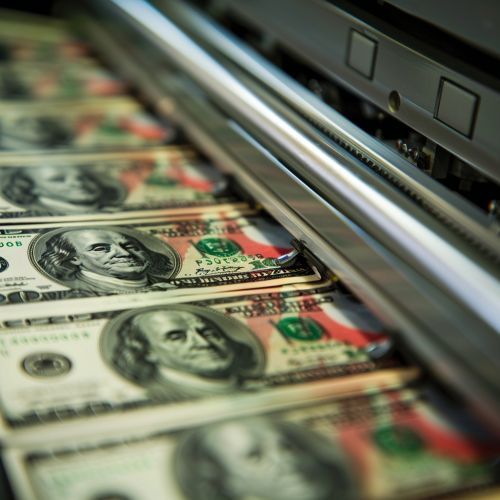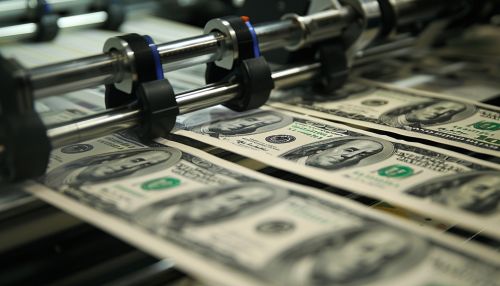Digital Counterfeiting: Difference between revisions
(Created page with "== Introduction == Digital counterfeiting refers to the creation and distribution of fraudulent digital assets, including currency, documents, software, and multimedia. This phenomenon has grown in complexity and prevalence with the advancement of digital technologies, posing significant challenges to security, economic stability, and intellectual property rights. == Historical Context == The concept of counterfeiting is not new; it dates back to ancient civilizations w...") |
No edit summary |
||
| Line 100: | Line 100: | ||
[[Category:Cybercrime]] | [[Category:Cybercrime]] | ||
[[Image:Detail-96249.jpg|thumb|center|High-resolution image of counterfeit currency being printed on a digital printer.|class=only_on_mobile]] | |||
[[Image:Detail-96250.jpg|thumb|center|High-resolution image of counterfeit currency being printed on a digital printer.|class=only_on_desktop]] | |||
Latest revision as of 16:42, 4 July 2024
Introduction
Digital counterfeiting refers to the creation and distribution of fraudulent digital assets, including currency, documents, software, and multimedia. This phenomenon has grown in complexity and prevalence with the advancement of digital technologies, posing significant challenges to security, economic stability, and intellectual property rights.
Historical Context
The concept of counterfeiting is not new; it dates back to ancient civilizations where counterfeit coins and documents were produced. However, the digital era has transformed counterfeiting into a sophisticated and widespread issue. The advent of digital technology and the internet has facilitated the creation and dissemination of counterfeit items at an unprecedented scale.
Types of Digital Counterfeiting
Digital counterfeiting encompasses various forms, each with distinct characteristics and implications.
Counterfeit Currency
Digital counterfeiting of currency involves the creation of fake digital money, such as cryptocurrency or electronic fiat currency. This type of counterfeiting can undermine financial systems and erode trust in digital payment methods.
Counterfeit Documents
Counterfeit documents include fake identification documents, certificates, diplomas, and other official records. These fraudulent documents can be used for identity theft, fraud, and other illegal activities.
Counterfeit Software
Counterfeit software refers to unauthorized copies of software programs. This type of counterfeiting can lead to significant financial losses for software developers and pose security risks to users due to the potential inclusion of malware.
Counterfeit Multimedia
Counterfeit multimedia includes pirated movies, music, and digital art. This form of counterfeiting infringes on intellectual property rights and deprives creators of their rightful earnings.
Techniques and Methods
Digital counterfeiters employ various techniques to create and distribute fake digital assets.
Digital Scanning and Printing
High-resolution scanners and printers are used to create counterfeit documents and currency. These devices can produce near-perfect replicas of original items.
Software Cracking
Software cracking involves modifying software to disable copy protection mechanisms. This allows counterfeiters to distribute unauthorized copies of software without restrictions.
Digital Watermark Removal
Digital watermarks are used to protect multimedia content. Counterfeiters use specialized software to remove these watermarks, making it difficult to trace the origin of pirated content.
Phishing and Social Engineering
Phishing and social engineering techniques are used to obtain sensitive information, such as login credentials and personal details, which can then be used to create counterfeit digital identities.
Impact and Consequences
The impact of digital counterfeiting is far-reaching, affecting individuals, businesses, and governments.
Economic Impact
Digital counterfeiting results in significant financial losses for businesses, particularly in the software and entertainment industries. It also undermines consumer confidence in digital transactions.
Security Risks
Counterfeit digital assets can pose serious security risks. For example, counterfeit software may contain malware that can compromise user data and systems.
Legal and Regulatory Challenges
The global nature of digital counterfeiting presents legal and regulatory challenges. Different jurisdictions have varying laws and enforcement mechanisms, making it difficult to combat digital counterfeiting effectively.
Prevention and Mitigation
Various strategies and technologies are employed to prevent and mitigate digital counterfeiting.
Digital Rights Management (DRM)
DRM technologies are used to protect digital content from unauthorized copying and distribution. These technologies include encryption, access controls, and digital watermarks.
Blockchain Technology
Blockchain technology offers a decentralized and tamper-proof method for verifying the authenticity of digital assets. It is increasingly used to combat counterfeit currency and documents.
Legal Frameworks
Governments and international organizations are developing legal frameworks to address digital counterfeiting. These frameworks include stricter penalties for counterfeiters and enhanced cooperation between jurisdictions.
Public Awareness
Raising public awareness about the risks and consequences of digital counterfeiting is crucial. Educating consumers and businesses about how to identify and avoid counterfeit digital assets can help reduce the prevalence of this issue.
Case Studies
Several notable cases highlight the impact and complexity of digital counterfeiting.
Case Study 1: Counterfeit Cryptocurrency
In 2017, a counterfeit cryptocurrency scheme defrauded investors of millions of dollars. The counterfeiters created a fake cryptocurrency and promoted it through social media and fraudulent websites. The scheme was eventually uncovered, but not before significant financial damage had been done.
Case Study 2: Fake Diplomas
In 2019, a large-scale operation producing fake diplomas was uncovered. The counterfeiters used high-quality printing techniques and digital signatures to create realistic-looking diplomas, which were sold to individuals seeking to bypass educational requirements.
Case Study 3: Pirated Software
A major software company lost millions in revenue due to widespread distribution of pirated versions of its flagship product. The counterfeit software was distributed through various online platforms, and many users were unaware that they were using unauthorized copies.
Future Trends
The future of digital counterfeiting will likely be shaped by advancements in technology and changes in regulatory landscapes.
Artificial Intelligence and Machine Learning
Artificial intelligence (AI) and machine learning (ML) technologies can be used to detect and prevent digital counterfeiting. These technologies can analyze patterns and anomalies in digital assets to identify potential counterfeits.
Enhanced Digital Authentication
Advancements in digital authentication methods, such as biometric verification and advanced encryption, will improve the ability to verify the authenticity of digital assets.
International Cooperation
Increased international cooperation will be essential to combat digital counterfeiting effectively. Collaborative efforts between governments, businesses, and international organizations will help create a unified approach to addressing this issue.
See Also
References


